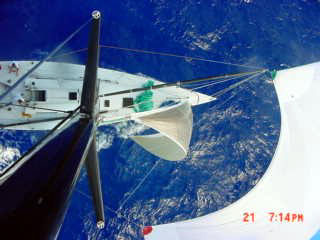Friday July 21st
Position: Latitude: 22 25 North Longitude: 152 57 West, Course Over Ground: 256 true, Speed Over Ground: 13 knots
Skipper’s notes: Pegasus flew right through the night. With great speed and smarts the mighty Pegasus executed the second phase of our plan. If you remember, in the first phase of this race, after finding some very light winds, Pegasus went all the way South to be the first boat to the tradewinds, sailing more miles, but betting that we would make it up with boat speed once we found the stronger winds. A gambit that really paid off. The second phase of our plan was to surprise our competitors and come back with great speed across their course line, ahead of them, in order to position ourselves between them and the finish line. To get the effect of surprise we wanted the competition thinking that we were committed to being the most Southward boat. This is all of course easier said than done. In order to place ourselves between the competition and the finish line, we needed to gibe on the wind shifts throughout the night. When the wind is blowing 20 knots in the pitch black night it takes perfect crew work and great timing to execute these complex maneuvers. I must say that the team is doing an absolute fantastic job: We executed half a dozen gibes flawlessly, while surfing down the North Pacific waves at night. After the first couple of gibes, it became routine and simple process and we continued to gibe on the wind shifts throughout the day. We are still more than 24 hours from the finish line and a lot can still happen. But so far so good, everything is working out as planned. Knock on wood. There is a big part of offshore sailboat racing that is like playing chess. Pegasus may now have the upper hand. We’ll get confirmation soon enough as the finish line is so close. For now, sailing is incredibly pleasant. Perfect. Strong trade winds that challenge our steering skills into a dance with the waves. Classic North Pacific trade wind sailing. As Pegasus’ hull slices through the waves while schools of flying fish fly away, making 100+ feet flights out of the water. Flying fish have developed the skill of flight to escape predators. To the flying fish, Pegasus is a giant 70 feet carbon fiber predator with huge wings: Better get out of the way fast. I think that the first sign of the Islands came with a glimpse of a few dolphins that looked like they were chasing tuna. Wherever there are big schools of tuna, there are dolphins. That’s because to our dolphin friends, these schools of tuna are a giant “all you can eat sushi bar.” Which brought back discussions of food among the team: After eating freeze dried meals for a week what is going to be our first stop? Well almost invariably, everyone says “Fresh Sushi.” Heck if we could have caught a female flying fish, we could have had Tobiko, which is flying fish row. Then again, Greg could have caught my friend the mermaid and he could have even gotten his socks back! The color of the water has now notably changed to emerald blue. At sundown we’re focusing on getting to the finish line as fast as we can and trying to keep any competitors from passing us. Pegasus is taking flight for the night through windy squalls and surfing down giant waves. Go Pegasus, go!…..

Greg and Brent doing a spinnaker peel change

Huge spinnaker flying!

The color of the water has changed.
ephoto by Brent, from the top of the mast.
Friday July 21st
Position: Latitude: 22 25 North Longitude: 152 57 West, Course Over Ground: 256 true, Speed Over Ground: 13 knots
Skipper’s notes: Pegasus flew right through the night. With great speed and smarts the mighty Pegasus executed the second phase of our plan. If you remember, in the first phase of this race, after finding some very light winds, Pegasus went all the way South to be the first boat to the tradewinds, sailing more miles, but betting that we would make it up with boat speed once we found the stronger winds. A gambit that really paid off. The second phase of our plan was to surprise our competitors and come back with great speed across their course line, ahead of them, in order to position ourselves between them and the finish line. To get the effect of surprise we wanted the competition thinking that we were committed to being the most Southward boat. This is all of course easier said than done. In order to place ourselves between the competition and the finish line, we needed to